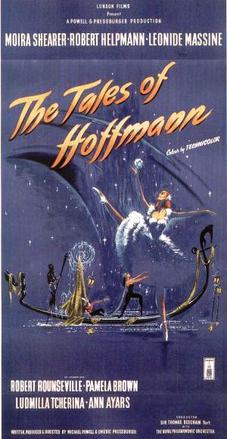| The Tales of Hoffmann | |
|---|---|
 Theatrical release poster | |
| Directed by | |
| Written by |
|
| Produced by |
|
| Starring | Moira Shearer Robert Helpmann Léonide Massine Robert Rounseville Pamela Brown Ludmilla Tchérina Ann Ayars |
| Cinematography | Christopher Challis |
| Edited by | Reginald Mills |
| Music by | Jacques Offenbach |
Production companies | |
| Distributed by | British Lion Films |
Release dates |
|
Running time |
|
| Country | United Kingdom |
| Language | English |
| Box office | |
The Tales of Hoffmann is a 1951 British Technicolor comic opera film written, produced and directed by the team of Michael Powell and Emeric Pressburger working under the umbrella of their production company The Archers. It is an adaptation of Jacques Offenbach's 1881 opera The Tales of Hoffmann , itself based on three short stories by E. T. A. Hoffmann.
Contents
- Plot
- Adaptation
- Cast
- Production
- Reception
- Critical response
- Accolades
- Soundtrack
- 2015 re-release
- Notes
- References
- Bibliography
- External links
The film stars Robert Rounseville, Moira Shearer, Robert Helpmann and Léonide Massine and features Pamela Brown, Ludmilla Tchérina and Ann Ayars. Only Rounseville and Ayars sang their own roles.
The film's soundtrack consists of music conducted by Sir Thomas Beecham and played by the Royal Philharmonic Orchestra. In addition to Rounseville and Ayars, singers included Dorothy Bond, Margherita Grandi, Monica Sinclair and Bruce Dargavel. The film's production team included cinematographer Christopher Challis and production and costume designer Hein Heckroth, who was nominated for two 1952 Academy Awards for his work.